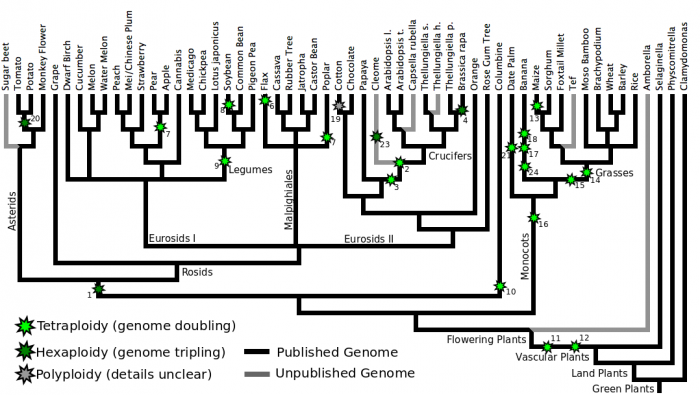Plant paleopolyploidy
The plant lineage, and specifically angiosperms, have a genomic history of repeated whole genome duplication events. This pattern of changing their ploidy level (or number of copies of their genome) is something that happens frequently today, and many domesticated crop plants have been selected with various ploidy levels. While the mechanisms are unknown that permit polyploidy is some lineages such as plants, and not as frequently in others such as mammals [1].
Identifying and characterizing plant paleopolyploidies is ongoing research. They are identified through whole genome comparisons using a combination of the data derived from genomic structure (e.g. syntenic dotplots) and evolutionary distances (e.g. synonymous mutation rates). As such, detecting these events and determining which lineages share what subset are continually changing. The images presented here represent our views right now, but are subject to change. Events that were previously undetected or missed can suddenly be seen with an improved build of a genome or the the sequencing of a fortuitously placed outgroup.
As new genomes become available, and previous genomes are updated, we will continue to improve these figures.
Plant Phylogenetic Tree With WGD Marked

Discussion of individual tetraploidies
1 Eudicot Hexaploidy
2 Arabidopsis alpha
3 Arabidopsis beta
4 Brassica hexaploidy
5 Poplar tetraploidy
6 Cucumber tetraploidy
7 Apple tetraploidy
8 Soybean tetraploidy
9 Legume tetraploidy
10 Columbine tetraploidy
11 Flowering plant tetraploidy
12 Seed Plant Tetraploidy
13 Maize Tetraploidy
14 Grass Tetraploidy
15 Monocot Tetraploidy A
16 Monocot Tetraploidy B
- ↑ There is a case of a tetraploid rodent: Gallardo. 2006. Molecular cytogenetics and allotetraploidy in the red vizcacha rat, Tympanoctomys barrerae (Rodentia, Octodontidae) Genomics. 88:2, 214-221. doi:10.1016/j.ygeno.2006.02.010